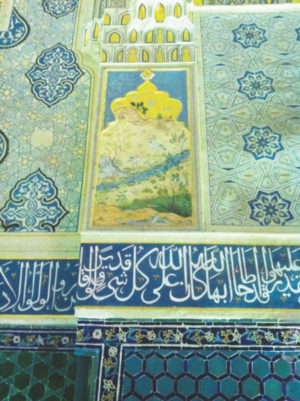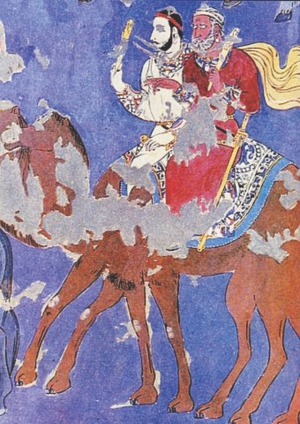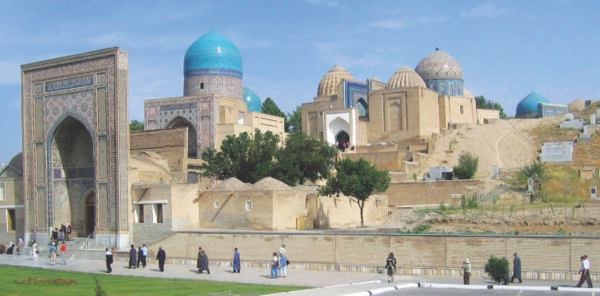| Home - Back Issues - The Team - Contact Us |
 |
| Volume 11 |Issue 45| November 16, 2012 | |
|
|
A Roman Column
A CENTRAL ASIAN JOURNEY The Other Samarkands Neeman Sobhan Once upon a millennium there was a city called Markanda. Actually, that was Samarkand's Greek name given by Alexander the king of Macedon when he conquered this capital of the Sogdian Satrapy of the ancient and sprawling Persian Achemenid empire of Cyrus and Darius, replacing Zoroastrianism with Hellenistic concepts in the region. We are talking about 329 B.C or BCE (Before Common Era if one wishes to be neutral). I have no problem with the old system of designating world events by the birth and death of Christ. I am used to reading the past as A.D or B.C. However, in Samarkand, what is harder to get used to, are the numbers that precede these qualifiers. Talking of 700 or 600 B.C (when thisone of the oldest existing city in the world, was first established as Afrasiab), to 1800 A.D (when, having flourished through a variety of empires and been destroyed and rebuilt by other dynasties, it was finally abandoned to be a prop on the stage of history), that's a lot of centuries! Visiting this area is trying to swim in the River of Time. It is all swirling there, the ancient past, the remote past, the medieval past, and the recent past. Suddenly tiny voices bubble forth from the bottom. Names, titles, terms learnt a lifetime ago in history books call out: The Parthians, the Scythians, the Assyrians, the Akkadians, the Sassanids, the Safavids, Ghaznavids, Ghor, Iran-Turan, the Seljuks, the Abbasids, the Ottomans, the Seleucids, Sumerians, Mongols, Bactria, the Levant, Mesopotamia (modern Iraq), Babylon, Transoxiana, the Avesta, Satrapy, and more.
Figures in miniature paintings; mythic characters from fiction, poetry and songs; heroes of epics and legends, all shimmer forth: Afrasiyab fighting Siyahvush, the rider of the black stallion after training under Rostam in Ferdousi's Shahnama or Book of Kings, or the fictitious Sassanid king Shehryar and his fair storyteller Shehrazade from the Alif Layla or A Hundred and One nights, or relics from half standing Zoraostrian temples, bent Hellenistic coins, or shards of pre-Islamic pottery, or a page of Abbassid-era document, or a link from the chain-mail of Turkish armour, or a rag of Chinese tapestry. It's a Disneyworld for history buffs. We had started our journey thinking to see the Samarkand of Amir Temur and on arriving, realised that we had pulled at a thread in the fabric that has knit this city through many ages, unraveling the following timeline (which showed us that what is actually left to admire in its most preserved and accessible form is only the most recent): 8-7 B.C to 6 A.D See in Afrasiab Museum.: Mural paintings of this time, and oldest surviving chessmen. 4 B.C 2 B.C First Millenium AD 7-8 A.D 9-10 A.D 11-12 A.D 13 A.D 1220 14-15 A.D 16 A.D 18 A.D 1868-1991 Faced with such a fascinating calendar, my suggestion to others would be to visit the Afrasiab Museum to see the murals and other Sogdian and pre-Arab relics, and for the rest to pick a few monuments and ruins from other centuries.
Given our own time limit, we went straight to the Shah-e-Zinda complex, which for me became the most memorable site in Samarkand, consisting of a series of gorgeously decorated and by now reconstructed mausoleums, tombs and crypts. Contrary to the impression one would get from its designation as a necropolis, it is the most colourful spot in Samarkand, a flowering forest of buildings all in different shades of blue: turquoise, azure, lapis dark, blue-green and greenish blue, embroidered with other colours. Each building is a jewel in a long open corridor reached by a flight of stairs from the portal at street level. It is a magnificent place to stroll down gazing at some twenty buildings dating from 9th to the 14th century. The prettiest tombs were the ones of women, such as Temur's sisters and neices. Photos fail to do justice; only the eyes record. The name Shah-i-Zinda (meaning "the living king") refers to the grave of Qusam ibn Abbas, a cousin of the prophet Muhammad, who supposedly was the first to introduce Islam to Central Asia in 676 A.D. Under the Abbasids the legend grew that on being beheaded, he took his head and went into a deep well, where he's still living now! Ibn-e-Battuta, the famous traveler said that the shrine was so venerated that it was not destroyed even by Chengez Khan. Talking about shrines, we plan to see next, outside Samarkand in a beautiful spot next to a gurgling book, the supposed tomb of Prophet Daniel (Khodja Danyar) and on our way to Bokhara, the tomb of Imam Bokhari, famous for compiling the Hadith, referred as Bokhari Sharif. More on these, next time. |
||||||||
Copyright
(R) thedailystar.net 2012 |


